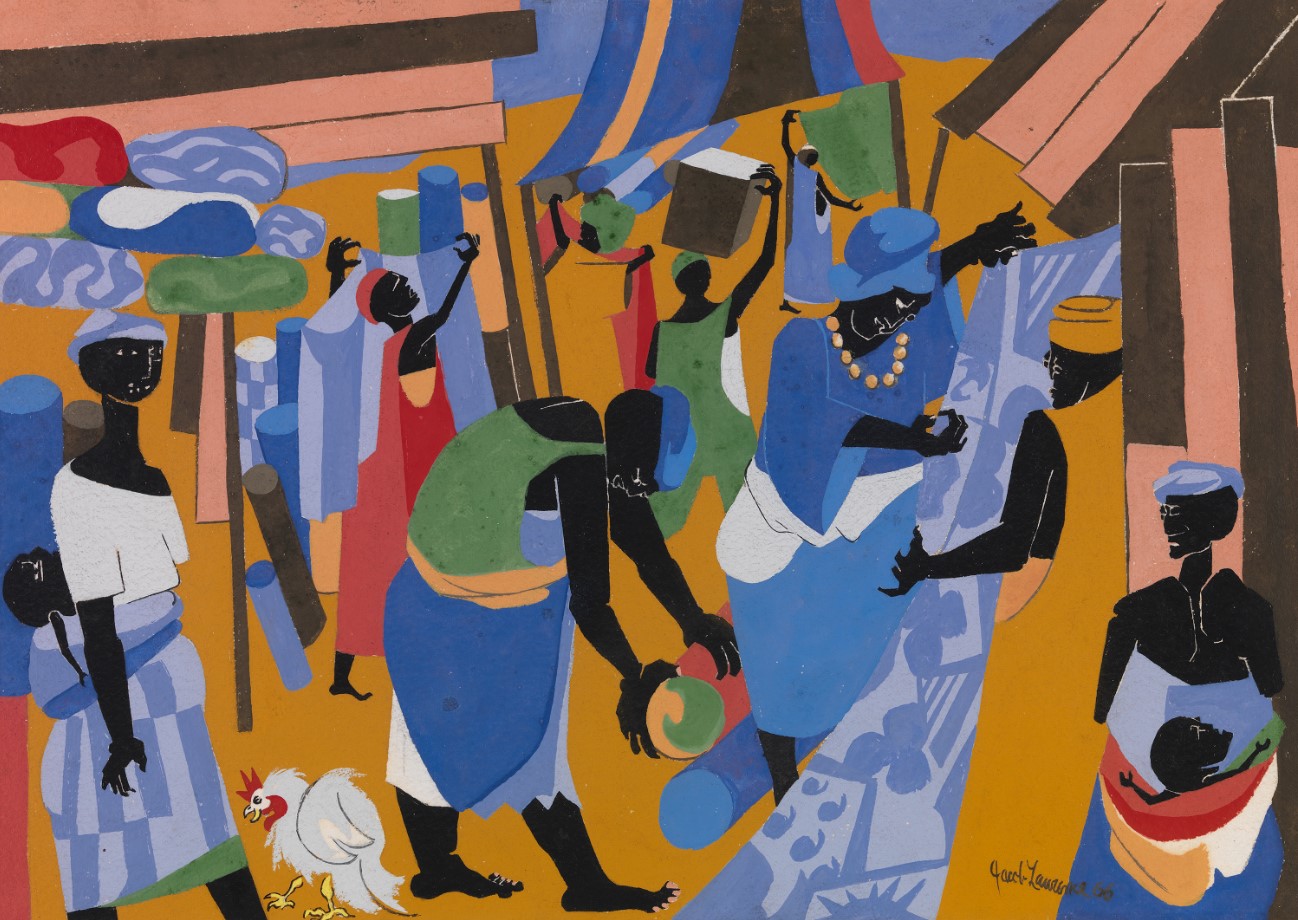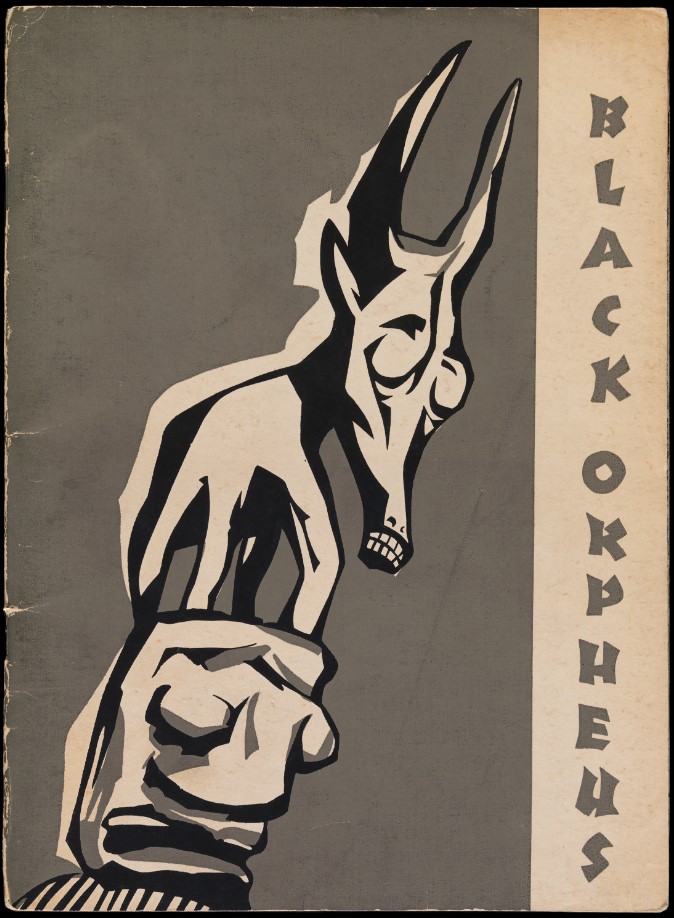Chrysler Museum
October 7, 2022, to January 8, 2023
New Orleans Museum of Art
February 10 to May 7, 2023
Toledo Museum of Art
June 3 to September 3, 2023
The exhibition features more than 125 objects, including paintings, sculptures, reliefs and works on paper. Lawrence’s Nigeria series (1964-65) anchors the exhibition and appears alongside works by several Mbari Artists and Writers Club members, including Duro Ladipo, Twins Seven-Seven, Muraina Oyelami, Asiru Olatunde, Jacob Afolabi and Adebisi Akanji. The show also includes letters Lawrence wrote to his friends in the United States about his experiences in Nigeria and copies of Black Orpheus (1957-67), the Nigeria-based literary journal that showcases the works of modernist African and African Diasporic writers and visual artists.
“The Toledo Museum of Art holds several works by Jacob Lawrence in the permanent collection. Black Orpheus: Jacob Lawrence and the Mbari Club presents an important opportunity to broaden our understanding of Lawrence’s life as well as the history of modernism as a transcontinental phenomenon. This exhibition aligns strongly with the Toledo Museum of Art’s belief that a more inclusive narrative of art history is a truer one, and we could not be more excited to host this important and visually stunning show,” said Adam Levine, the Toledo Museum of Art’s Edward Drummond and Florence Scott Libbey director.
Kimberli Gant, Ph.D., the exhibition’s co-curator, embarked on the research nearly six years ago to bring together artworks from institutions and private collections around the world along with out-of-print copies of Black Orpheus magazine. Together, the objects transport visitors to Nigeria during a time when several countries in Africa and around the world were establishing their independence from European colonialism. Black Orpheus displays how artists grappled with representing their respective national and cultural identities while depicting visually striking works during the beginning of the postcolonial period throughout the African continent and other parts of the world. The resulting objects were meant to resonate with local communities while connecting to broader Eurocentric notions of modernity.
“As the civil rights movement peaked in the United States, Jacob Lawrence traveled to Lagos. Last year marked the 60th anniversary of his first exhibition and visit to Nigeria and the 65th anniversary of Black Orpheus,” said Gant. “This show is the first museum exhibition of Lawrence’s Nigeria series and introduces new scholarship about a little-known period in his life that included a nine-month stay in Nigeria in 1964. Through the works on view, visitors will gain insight into Lawrence’s conversations with Nigerian, Ethiopian, Sudanese and Ghanian artists and discover how those interactions influenced him long after he returned to the United States. Lawrence’s global impact is also evident in the works on view by other international artists.”
The exhibition is organized into five sections that offer insight into Lawrence’s experiences and emphasize the global diversity of the artists affiliated with Black Orpheus and the Mbari Artists and Writers Club. Nigeria, the first section of the exhibition, introduces viewers to Lawrence’s representation of the country through depictions of its splendid markets, complex communities and permeable spiritual practices. Artists of Osogbo follows with works of several little-known Nigerian artists who learned a range of artistic traditions—printmaking, batik textiles and painting—from older generations of Western and non-Western artists. Their images inspired younger generations. Zaria Art Society showcases a small group of Nigerian artists who met at the National College of Art & Technology and developed a philosophy called “natural synthesis,” where the artists incorporated local aesthetics and cultural traditions with western-style art techniques to create a new modern art form. Across the African Continent features artists from other countries outside of Nigeria who also trained in European art styles yet featured iconography and stories from their own cultures as modes of new artistic expression. The exhibition concludes with Beyond the African Continent, featuring artists from around the world whose dynamic creations mirrored those of their counterparts in Africa.
“This exhibition highlights artists based outside the accepted art centers of the United States and Europe and reveals the nuances of global modernist art practices during the mid-20th century,” said Gant. “Some used their artistic practice to reflect Nigeria’s and Africa’s post-colonial era while others communicated the sociopolitical issues they were facing in their respective countries. Lawrence’s Nigeria series represents an ongoing legacy of African American artists venturing to the African continent for knowledge and inspiration.”
Black Orpheus: Jacob Lawrence and the Mbari Club is co-organized by the Chrysler Museum of Art and the New Orleans Museum of Art. It is curated by Kimberli Gant, Ph.D., the Brooklyn Museum’s curator of modern and contemporary art and the Chrysler Museum of Art’s former McKinnon curator of modern and contemporary art, and Ndubuisi Ezeluomba, Ph.D., the Virginia Museum of Fine Art’s curator of African art and the New Orleans Museum of Art’s former Françoise Billion Richardson curator of African art.
A full-color catalogue published by Yale University Press will accompany the exhibition and include essays by the exhibition curators and preeminent scholars including Leslie King Hammond and Peter Probst as well as a new generation of scholars bringing forward new scholarship including Suheyla Takesh, Katrina Greven and Iheanyi Onwuegbucha.

Jacob Lawrence (American, 1917–2000), Market Scene, 1966. Gouache on paper. Chrysler Museum of Art, Museum purchase 2018.22. © 2022 The Jacob and Gwendolyn Knight Lawrence Foundation, Seattle / Artists Rights Society (ARS), New York.

Cover of Black Orpheus Journal #5, May 1959 Collection of Philip Peek, Sanbornton
Photo: Sesthasak Boonchai